Parinov I.A. Microstructure and Properties of High-Temperature Superconductors
Подождите немного. Документ загружается.

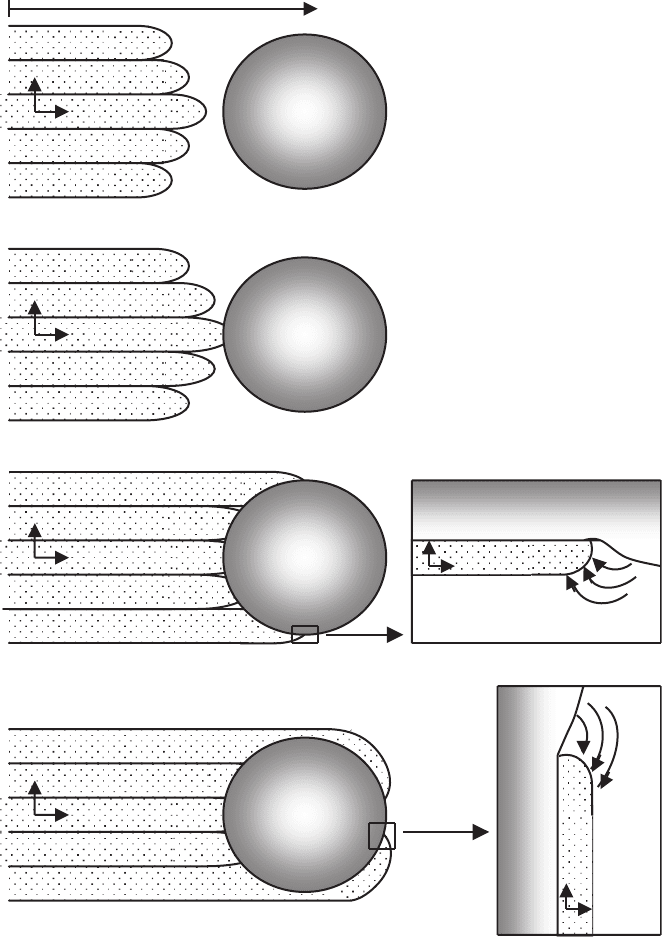
320 7 Modeling of YBCO Oxide Superconductors
123
R
211
Liquid
A
123
Liquid
A
B
B
Liquid
B
B
Liquid
B
B
C
123 C
C
C
211
211
123
211
211
123
Liquid
Y
Y
211
123
Liquid
c
a
c
a
c
a
c
a
c
a
c
a
(a)
(b)
(c)
(d)
Fig. 7.16. Competing growth of 123 platelets near a 211 particle, leading to quasi-
single crystalline material via a zipper-like mechanism. (a) The platelet closest to
the 211 particle forms a bridge, (b)thec-axis growth of platelet A is in competition
with the fast ab-plane growth of the adjacent platelet B,(c, d) explain enlarged
platelet thickness of the outer platelets after passing the particle [936]

7.1 Modeling of 123 Phase Solidification from Liquid 321
(a)
(b)
20 μm
123
r
r
2r
C
a
2r
r
211
211
211
Fig. 7.17. (a) A zipper mechanism and (b) experimental evidence for this mecha-
nism [936]

322 7 Modeling of YBCO Oxide Superconductors
211
123
(a)
123
123
123
211
211
211
123
(b)
(c)
123
Fig. 7.18. 123 pseudo-grains (platelets), passing a 211 particle of approximately
the same dimensions. Predominant growth, when passing the particle is in the paper
plane in the case (a) and in a plane perpendicular to the paper plane, but parallel
to the ab-planes, in the cases (b)and(c) [936]
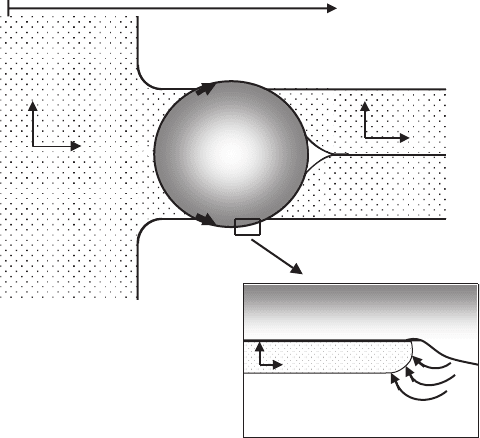
7.1 Modeling of 123 Phase Solidification from Liquid 323
211
123
Liquid
Y
c
a
211
R
Liquid
c
a
123
123
c
a
Fig. 7.19. Change in the growth morphology of a planar 123 interface, evoked by
a 211 particle [936]
7.1.5 Modeling of Solidification Kinetics
Only thermodynamic and chemical representations cannot totally describe
growth processes in the Y(RE)BCO compounds. It is also necessary to in-
clude in consideration a kinetic process of the 123 phase solidification. As is
followed from tests [1104], during the growth processes, the residual phases are
pushed and distributed along the growing steps and sometimes are trapped
in the 123 matrix, leading to the formation of microcracks. Their shape
correlates with the rapid lateral growth that occurs in the ab-plane. This
can lead to the formation of multi-grain domains as schematically drawn in
Fig. 7.20.
Computer simulation of 2D growth kinetics of 123 front near 211 particles
in the ac-andab-plane is carried out in [1104] on the basis of Eden kinetics
model (see Appendix D) for stochastic cell-by-cell growth of compact clusters.
On a square lattice, we take a box of size L with periodic boundary condi-
tions in the abscissa direction. The growing crystal is represented by the set
of occupied sites on the lattice (see Fig. 7.21). At each step of the growth, the
set of empty sites in contact with the growing surface defines the perimeter of
the solidification front (the circles show these sites). A site of the perimeter
is randomly occupied, following the probability rule described below. This
defines a new perimeter configuration, and the same process is repeated.
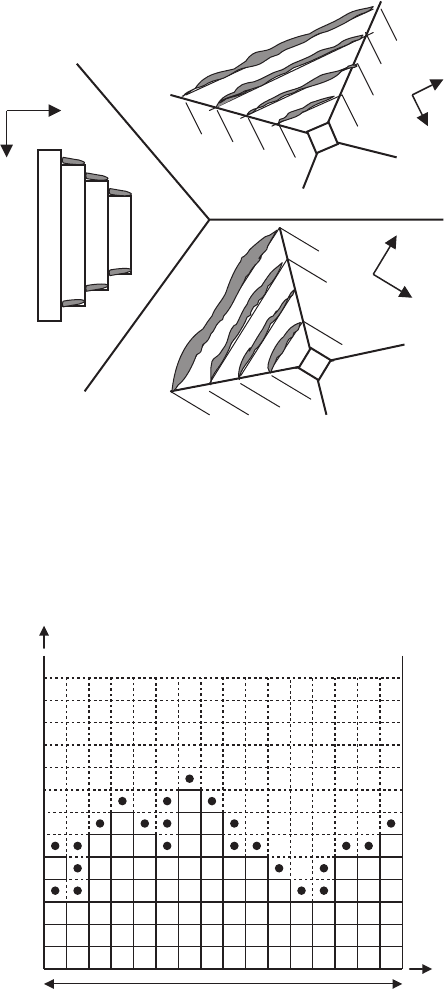
324 7 Modeling of YBCO Oxide Superconductors
a
b
a
b
c
a
Fig. 7.20. A pyramid-like picture, sketching the formation of a polycrystalline
region in the solidification process. Crystallographic orientations are emphasized
and residual phase (gray regions) along growing steps [1104]
L = 16
y
x
Fig. 7.21. Crystal front simulated using the isotropic Eden model. The black circles
illustrate the perimeter sites
7.1 Modeling of 123 Phase Solidification from Liquid 325
In such a model, an occupied site can represent a unit cell or a cluster of
123 cells.
It is known that an anisotropic growth rule simulates precipitation pro-
cesses [689], as well as the growth of cell colonies [52]. In order to simulate an
anisotropic growth front in the ab-andac-planes, we consider two variants of
the Eden model [1104]:
(1) Model I simulates the solidification front in the ac-orbc-plane, considering
a square lattice oriented in [100] and [001] directions. At each step of the
growth, a growing probability, P , is calculated on each perimeter site, and is
given by
P ∼ exp(p
a
N
a
+ p
c
N
c
) , (7.21)
where N
a
and N
c
are the number of occupied nearest neighbors (nn) in the a
and c directions, respectively; p
a
and p
c
are the anisotropic growth parameters.
Then, the set of these probabilities (defined on the perimeter) is renormalized
in the interval [0, 1]. A random number generator chooses the growing site
as in a Monte-Carlo simulation. This site is then occupied, defining a new
perimeter with the next repetition of the whole process.
Note that the exponential law simulates a curvature effect (or a so-called
Gibbs–Thomson effect) [1146]. When p
a
>p
c
, the growth probabilities are
more important in empty sites linked to the crystal, following the a-axis di-
rection. It results in a faster growth in the [100] direction than in the [001] di-
rection, simulating an anisotropic solidification process in the ac-plane. When
p
a
= p
c
= 0, the growth process reduces to a simple Eden’s model. When
p
a
<p
c
, the growth is trivial: the front remains flat and parallel to the sub-
strate (i.e., to the [001] direction).
(2) Model II simulates the solidification front in the ab-plane. In order to
simulate the [110] as the fast growth direction, the growth probability, P ,
calculated on each site of a square lattice is given by
P ∼ exp(p
nn
N
nn
+ p
dnn
N
dnn
) , (7.22)
where N
nn
and N
dnn
are the number of occupied nearest neighbor sites (nn)
in the [100] or [010] directions and diagonal nearest neighbor sites (dnn) in
the [110] directions, respectively; p
nn
and p
dnn
are the growth parameters.
The interaction with the diagonal nearest neighbors (dnn) is introduced in
this model in order to take into account the diagonal fast growth directions
in the ab-planes. When p
nn
= p
dnn
= 0, the model also reduces to the simple
Eden’s model.
In both models, the presence of 211 particles can be simulated, avoiding the
growth process to be achieved in circle-like regions of the square lattice. Thus,
the 211 particles play a passive role, in contrast to, for example, the models
[156, 475, 741], in which these particles provide with yttrium solidification
front of 123 phase.
The numerical results [1104], obtained on the basis of above models, es-
timate anisotropic effects of grain growth in the ab-plane (g
110
/g
100
∼ 10)

326 7 Modeling of YBCO Oxide Superconductors
and in the ac-plane (g
100
/g
001
∼ 50), where g
hkl
is the growth probability in
the crystallographic hkl directions. Replacing particles by spins [35], a mag-
netic field effect can be simulated and the magnetical texture growth processes
could be further analyzed [184].
7.1.6 Multi-phase Field Method
In order to minimize the processing time as well as improve texture of YBCO
melt-processed bulks, total information about solidification isotherm distri-
bution in time and in space is necessary. This also defines qualitative estima-
tions of a grain growth. The consideration of two-level scaling (in this case the
macroscopic study of thermal fields and microscopic grain growth processes)
decreases calculation time significantly. The macroscopic simulation of ther-
mal fields in the YBCO samples, sintered into a Bridgman furnace in existence
of the thermal insulation layer between the furnace and sample, has been car-
ried out in [956]. In order to simulate YBCO microstructure formation, three
different approaches could be used, namely (i) Monte-Carlo technique [800,
819, 822]; (ii) cellular automata models [302]; and (iii) phase field method
[113, 1142]. In this section, we consider in more detail the latter method. The
phase field conception has been applied to multi-phase system [1016], and also
to the microscopic simulation of the 123 platelets growth at the existence of
the 211 particles [956].
In the multi-phase field model, describing evolution of interphase bound-
ary, each phase is identified with individual phase field, and phase transfor-
mations between any neighbor pairs are considered depending on their own
characteristics. The phase field method [142, 1142], based on the Ginzburg-
Landau theory of phase transformations [452, 617, 737, 935, 986], was ap-
plied to the study of structural phase transformations of the “solid-solid”
type in [141]. The theoretical basis was the functional of the local density of
free energy, depending on an order parameter of the system and its partial
derivatives on the spatial coordinates. The order parameter can be a scalar
function, for example, concentration of solid component in the investigation
of the phase transformations of the “solid-liquid” type, which changes from 0
(in liquid) to 1 (in solid). [1016] was limited by the parameters, p
i
, describing
only local phase state of the system. In this case, each phase field is identified
either with melt or single 123 grain or 211 particle. Their time evolution is
described by the system of non-linear parabolic partial differential equations
[1016]:
˙p
i
=
n
#
k(k=i)
1
τ
ik
ε
2
ik
(p
k
∇
2
p
i
− p
i
∇
2
p
k
) −
p
i
p
k
2a
ik
[p
k
− p
i
− 2m
ik
(ΔT
ik
)]
,
(7.23)

7.1 Modeling of 123 Phase Solidification from Liquid 327
where the point, as usual, denotes the time derivative; the parameters τ
ik
,ε
ik
,
a
ik
and m
ik
can be defined through the test values (μ
ik
is the mobility, σ
ik
is
the surface energy and λ
ik
is the interface thickness) as [1142]
τ
ik
=
L
ik
λ
ik
T
ik
μ
ik
; (7.24)
ε
2
ik
= λ
ik
σ
ik
; (7.25)
a
ik
=
λ
ik
72σ
ik
; (7.26)
m
ik
=
6a
ik
L
ik
(T
ik
− T )
T
ik
. (7.27)
They calculate through a set of parameters, describing the phase transfor-
mation (i → k), namely (i) the equilibrium temperature of the phase transi-
tion, T
ik
(e.g., the melting temperature, T
m
, in solidification processes); (ii)
the heat release during phase transition, L
ik
(e.g., the melting heat in solidi-
fication problems); (iii) the driving force of the phase transition, m
ik
, defined
by deviation from equilibrium; and (iv) the difference, ΔT
ik
, between the
temperature of local cooling of the phase interface and the temperature, cor-
responding to a condition for the local equilibrium of i and k phases. These
equations are coupled with a diffusion equation, determining the local con-
centration of yttrium at any position and time. It may by shown that in
simulation of the superconducting structure solidification, the solution of con-
stitutive equation for i phase is required to find only near interface boundary
with neighbor phase. This set of differential equations is solved by a finite
difference technique, using rectangular lattice [1016].
Evolution of single phase, growing by isotropic way (e.g., liquid droplets in
gas media), leads during interaction of its structure elements to the formation
of 120
◦
-angles in triple points. In the case of multi-phase systems, the triple
junctions between different phases can be triple points of the “solid-liquid-gas”
type. Then, considerable difference between surface energies for the systems
“melt-solid”, “solid-gas” and “gas-melt” leads to formation of triple points
with angles different from 120
◦
.
Different crystallographic directions cause anisotropic behavior on ac-
count of crystallographic structure. The investigation of phase transition from
isotropic melt to anisotropic solid leads to corresponding change of equations
for phase fields. This is attained by either introduction of kinetic factor or
diffusion coefficient for phase field depending on the orientation of phase
boundary to the crystallographic directions of neighbor grains or phases.
The multi-phase conception may also be used to consider different grains
with various spatial orientations, belonging to the same phase. With this
aim in [1016], all orientations are divided into 10 orientation classes (the
Pott’s model), and each class is identified with own order parameter. Two-
and three-dimensional computed simulation of grain growth with different
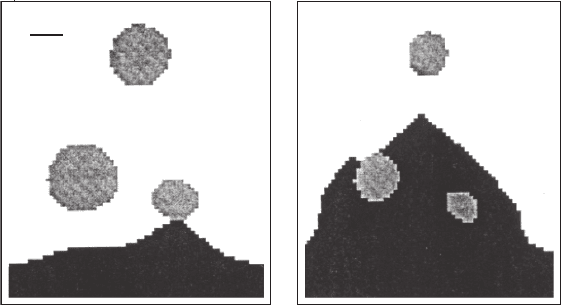
328 7 Modeling of YBCO Oxide Superconductors
crystallographic orientations has shown a dominant grain growth along the
direction of the solidification front propagation.
The couple consideration of the phase field equations for thermal and sol-
ubility fields allows the process of microstructure formation to be modeled
in actual peritectic systems (e.g., YBCO) [604]. The computer simulation re-
sults show coupling of the peritectic phase growth with a solubility of the
properitectic phase. Obviously, the properitectic particles dissolve in liquid
phase, according to their diameters (or surface curvature), increasing local
concentration of yttrium in surrounding melt. As has been shown above, a
microstructure of forming superconductor does not have not flat front, but
creates bridges between solidification front and properitectic particles [936].
When the 211 particles are sufficiently great, the time for their total disso-
lution before interaction with 123 front is insufficient. As a result, they are
trapped by the 123 matrix and can serve as pinning centers (see Fig. 7.22)
[956]. Based on the phase field conception [1016], the computer simulation of
a single particle in a population of 211 particles ahead of a growing 123 front
reveals a “virtual pushing” of the particle, displaying in its initial coarsening
before gradual and final dissolution (see Fig. 7.23) [938]. The computer results
show that a dissolution/re-precipitation mechanism at least contributes to the
displacement of the 211 particles ahead of a growing 123 front.
Another example of computer simulation [937, 956] relates to the geo-
metrically caused grain growth. In this case, the grain selection is found by
the conditions of their anisotropic growth. This example may be useful for
processing optimization of superconducting tapes. Moreover, the effects of
nuclei grains sizes can be investigated in this way. Computer simulation of
211 particles, defining superconducting properties of YBCO and forming X-
like precipitation, has been carried out in [937]. This yttrium enrichment of
the 123 grain diagonals leads to conclusion observed in experiment that the
2 µ m
Fig. 7.22. The microscopic simulation results, defining engulfment of 211 particles
and bridge formation [956]
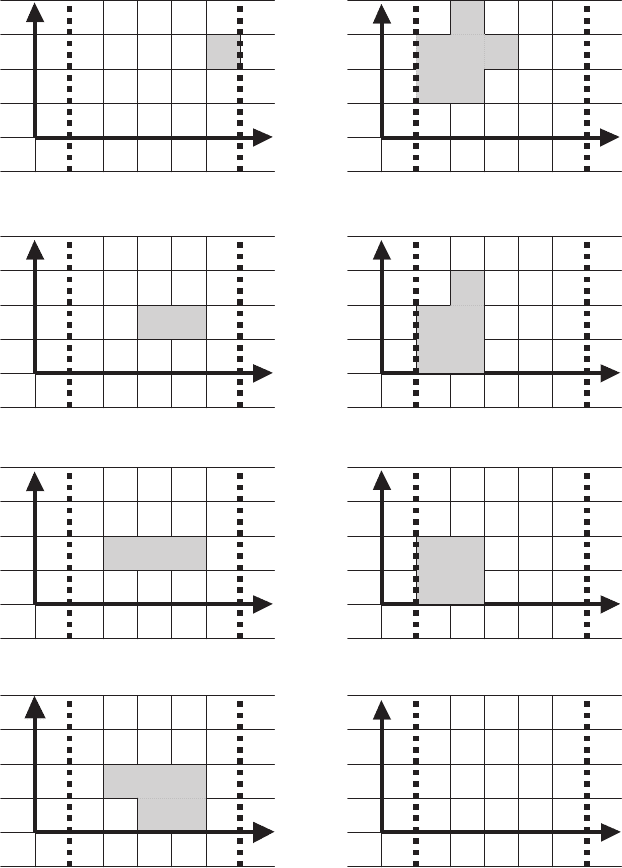
7.1 Modeling of 123 Phase Solidification from Liquid 329
(a) (e)
(b)
(c)
(f)
(g)
(d) (h)
Fig. 7.23. 211 particle ahead of a peritectic solidification front (the front grows from
right to left). The motion of the particle is shown relative to the grid in combination
with initial coarsening and then final dissolution [938]
